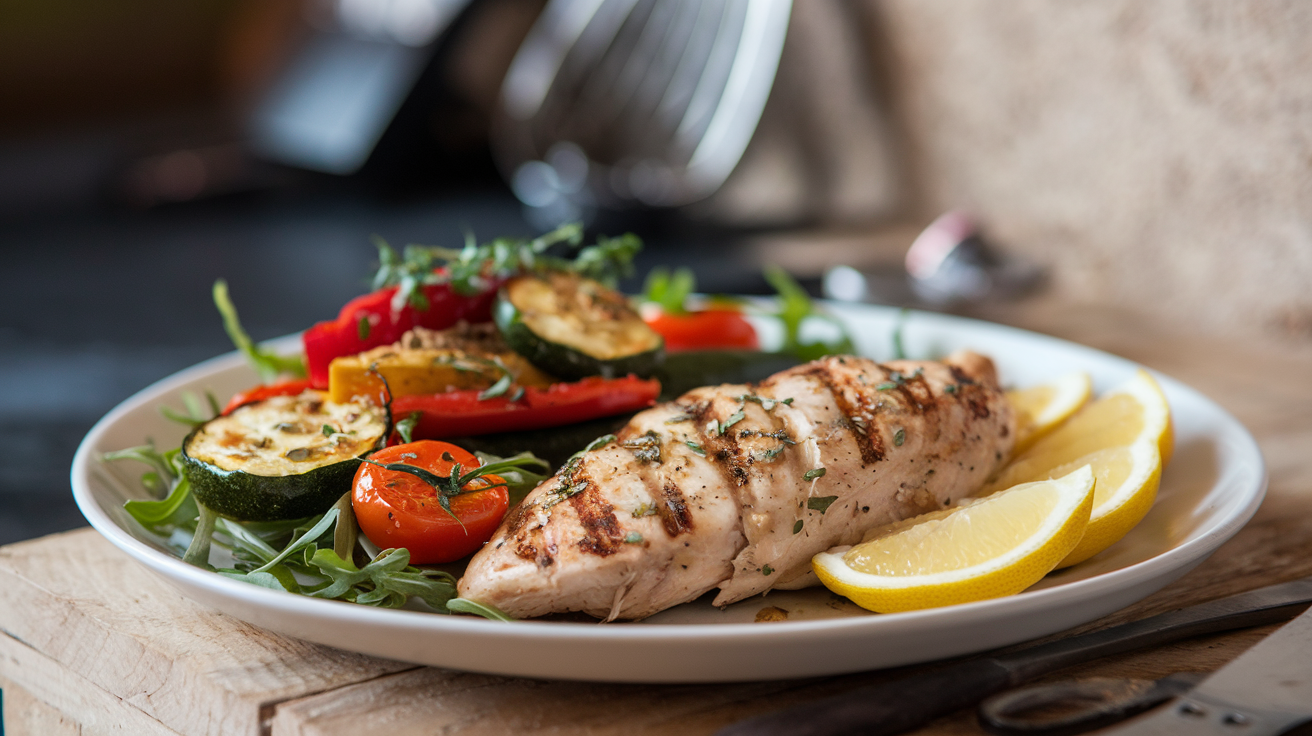Key points
• Use Natural Light: Try to use natural light when photographing food. It brings out the real colors and texture, making the meal look more inviting and full of life. Stay away from flash since it tends to cast annoying shadows and too bright spots.
• Compose with Angles and Styling: Play around with different angles to see which one shows off the dish best. Arrange props and style your shot carefully to add to the overall look and suggest a backstory to the food, like including fresh ingredients or old-fashioned crockery.
• Focus on Color and Contrast: Keep an eye on the color scheme and contrast in your shots. Pairing colors that set each other off and using a mix of lighter and darker parts will help make a photo that’s both eye-catching and makes the dish pop.
Contents
- Key points
- Getting to Grips with Food Photography
- Introduction to Food Photography
- Getting to Grips with Food Photography Basics
- The Importance of Lighting in Food Photography
- Natural Light vs. Artificial Light
- Making Shadows Softer for a Realistic Appearance
- Creating Mood with Lighting
- Aperture and Depth of Field in Food Photos
- Shutter Speed and Its Effects on Food Imagery
- ISO Settings and Noise Considerations
- Basic Editing Techniques for Food Photography
- Enhancing Colors and Contrast in Post-Production
- Cropping and Framing for Better Composition
- Playing with Angles for Unique Perspectives
- Macro Photography for Detail in Food
- Motion and Action Shots in Food Photography
- Dealing with Reflective Surfaces
- Maintaining Food Freshness During Shoots
- Overcoming Poor Lighting Conditions
- Exploring the Art of Food Photography
- Bringing Stories to Life Through Food Imagery
- Dabbling in Varied Styles and Genres
- Incorporation of Human Elements in Food Photography
- Selecting Your Best Work for a Portfolio
- Utilizing Social Media to Showcase Food Photography
- Networking and Collaboration Opportunities
- Staying Updated with Food Photography Trends
- Practicing Consistently to Hone Skills
- Attending Workshops and Courses for Improvement
- Frequently Asked Questions (FAQ)
Getting to Grips with Food Photography

Food photography is all about taking pictures that make the food look mouth-watering and enticing. It’s not just snapping shots of your meal; it’s about blending cooking artistry with visual narration to tell a story. A great photo can showcase how fresh the ingredients are, highlight the depth of the flavors, or remind you of good ol’ home cooking.
Introduction to Food Photography
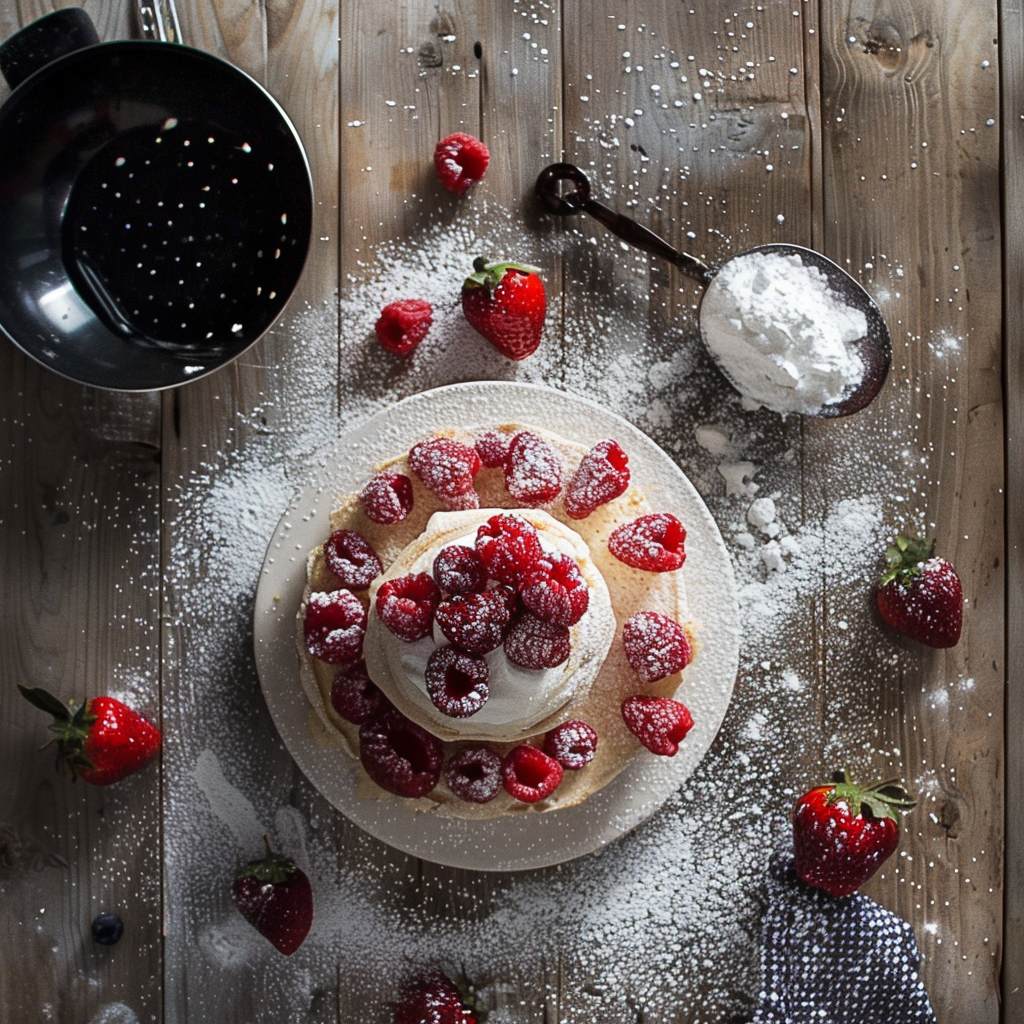
Starting with food photography means learning to take pictures that make food look so enticing, people feel like they can taste it just by looking. You’ll need to know about lighting, arranging your shot, and picking what goes around the food to set the scene. These skills are important for creating images that will get people’s attention, whether you’re shooting for a food blog, a restaurant menu, or your Instagram feed.
Let’s dig in:
Composition and Styling
In food photography, how you place things in your shot is key. It’s like organizing your plate to guide someone’s gaze through the image. The way you style your shot is just as important because the right props and backgrounds should add to the food’s appeal without taking over the spotlight.
Lighting Techniques
The light you use can change everything in your food photo. Natural light usually works best because it gently enhances food’s natural looks. But don’t worry – artificial light can be good too if you handle it well, especially when you need your photos to look consistent.
The Role of Camera Angles
Different angles can change how we see food in a photo. A bird’s-eye view is great for showing off a table spread, while side shots give us a closer feel of the dish. Choosing the right angle comes down to what you’re trying to highlight in your picture.
Color and Texture
Bright colors and textures can make a meal seem more appealing in a photograph. Making these pop might mean adjusting things like contrast and saturation, either when you take the photo or later on when you’re editing it.
To wrap up, whether you’re pretty new to this or you’ve been taking photos of food for a while, there’s always room to improve in food photography. It’s all about testing and trying new things till your images look as good as the dishes they feature.
Getting to Grips with Food Photography Basics
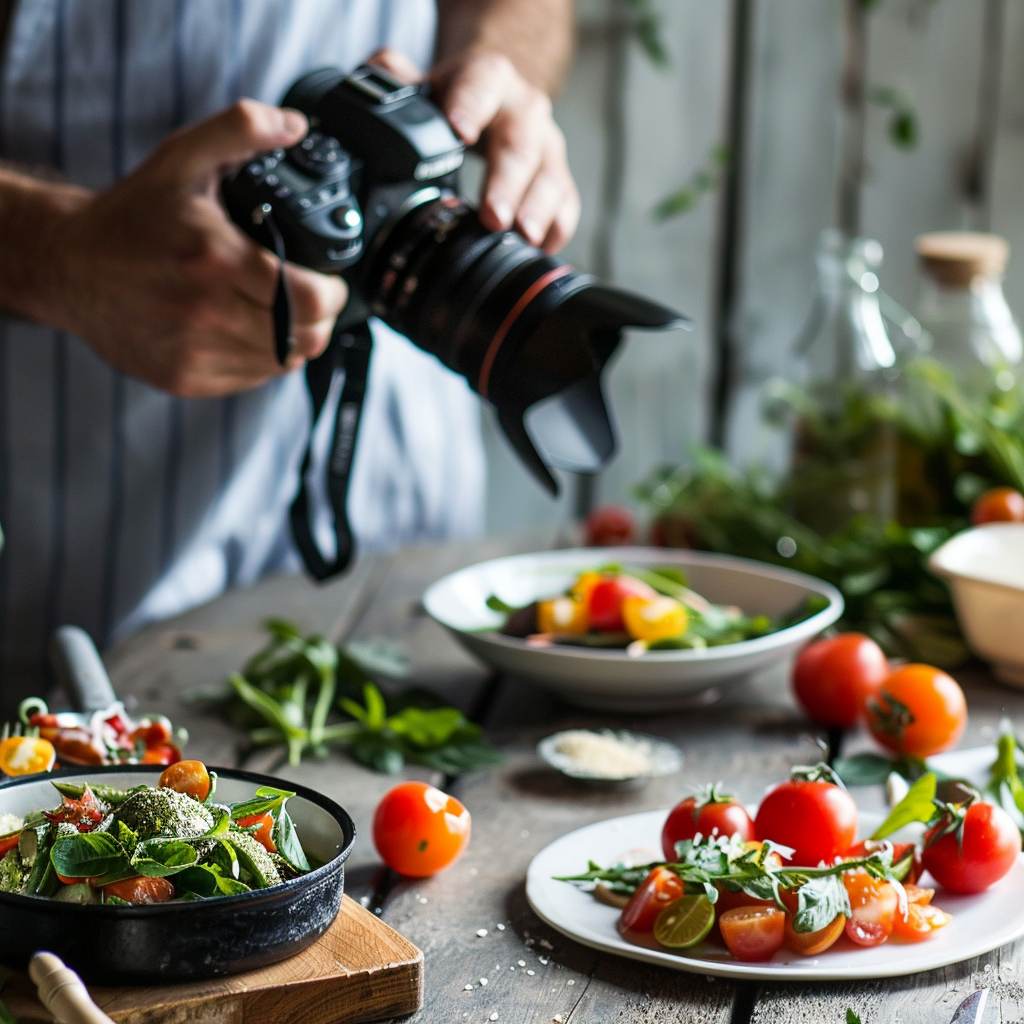
When you start with food photography, it’s crucial to understand the basics that turn a picture into a treat for the eyes, just like it’s a treat for the taste buds. So many things come together to create a stunning food photo, but light is usually king. Good lighting brings out the textures and shapes and sets the whole vibe of the picture. Get it right, and you’ve hooked your viewer’s appetite.
The Importance of Lighting in Food Photography
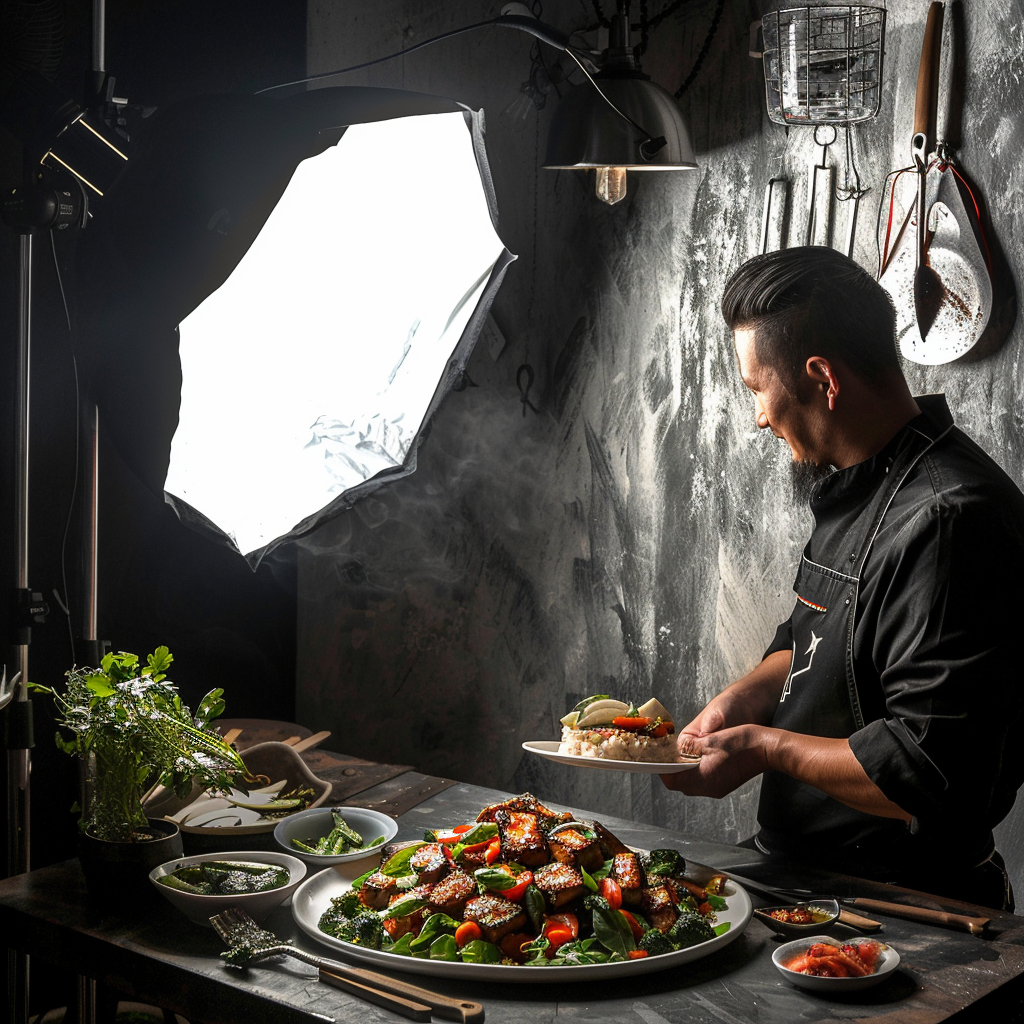
Think about enjoying a meal where every detail is perfectly lit. That’s what good lighting does in food photos. It brings out the darks and lights, shaping the food to look more tempting. While sunlight is often praised for giving food a natural and fresh look, artificial light is just as important. It gives you control and consistency, so you can capture every single crumb and shiny spot, no matter the time or weather.
The correct lights can turn a plain dish into a feast for the eyes. They direct your gaze, focusing on textures like the crunch of a crust or the silkiness of a mousse, and on colors that might not stand out otherwise. You could use backlighting to make your food glow or sidelighting for added sharpness. Each method makes its own mark on the final photo.
Bad lighting can make your photos dull and lifeless, but good lighting brings vibrancy and makes you want to reach out, take a bite, and savor. So in food photography, light is like an unseen cook that’s preparing a feast just for your eyes.
If you’re getting into food photography, knowing your camera settings is essential for snapping appealing pictures. The way you set up your camera can really improve how the food looks in photos.
Aperture
The opening of your camera’s lens, called the aperture, decides how much of the scene is sharp. For taking pictures of food, using a wide aperture (a small f-number) usually means more light gets in and your backdrop will stay out of focus. This puts all the attention on your dish.
Shutter Speed
If you want to stop movement and prevent blur from shaky hands or moving subjects, go for a quick shutter speed. On the other hand, if your subject is still and there’s enough light, a slower speed might work. Just don’t forget to use a tripod if you slow it down too much, or you’ll end up with blurry pictures because of camera shake.
ISO
ISO controls how bright your photo is by changing how sensitive the camera sensor is to light. Lower ISOs are better for food pictures because they keep the picture clear and free of “noise.” Unless you’re in a dim place, it’s best to stick with lower ISO numbers for top-quality images.
White Balance
Getting the white balance right means your food’s colors will look real-life. If it’s off, your photo might get a blue or yellow tint that makes the food seem less appetizing. Adjust this setting based on your lighting to make sure the colors are true-to-life.
Entering food photography is like stepping into a new world that asks for a lot of attention to detail and an understanding of how camera settings impact your photos. Getting these settings right might take time and practice, but they’re key to creating images that make people hungry.
The Rule of Thirds in Composition
It’s super important to know about the rule of thirds when you’re trying to make nice-looking food photos. This idea means dividing the image with two lines up and down and two across, making nine even pieces. Positioning your main subject at where those lines meet or along the lines helps you make images that are more balanced and draw people in. It’s an easy trick that guides viewers to the most important parts of your picture.
Keeping Your Composition Balanced
You need balance in your photo so no one thing takes over everything else, which results in calm and inviting shots. Think about the size, shape, and color of all items in view. By thoughtfully adding stuff like garnishes around your main dish, you make sure everything feels stable and flows together. This way nothing looks too packed or bare.
Picking Props for Food Styling
The props you choose are crucial for boosting how your food photos look. Props include things like silverware and bowls to napkins and kitchen tools. They add context or tell a story about the picture. When picking props, be sure they fit with the mood you’re going for and don’t pull attention away from the food itself. The right props should enhance your dish’s story without hogging the limelight.
The Effect of Color and Texture
Color and texture are really important when it comes to making drool-worthy food pics. Using contrasting colors can help dishes pop and give your photo some oomph, while using shades that match each other can set different vibes—warm earthy tones for cozy feelings or cool colors for a fresh look. Texture brings depth and realism too—it lets people imagine what the food might taste like just by looking at it. Crispy bits, shiny glazes, and little crumbs all help make you want to dig in just by seeing them.
Natural Light vs. Artificial Light
Exploring the world of food photography, you need to realize how important light is. Sunlight gives you a gentle and scattered effect that’s perfect for showing off food’s true colors and textures.
However, it’s only around during the day and can change with the weather. On the other hand, artificial lights like bulbs and LEDs let you adjust brightness and direction as you like. They’re useful when you’re stuck in a dark space or need light that stays the same. Still, they might add some unwanted tints and you often need extra gear to soften their glow.
Making Shadows Softer for a Realistic Appearance
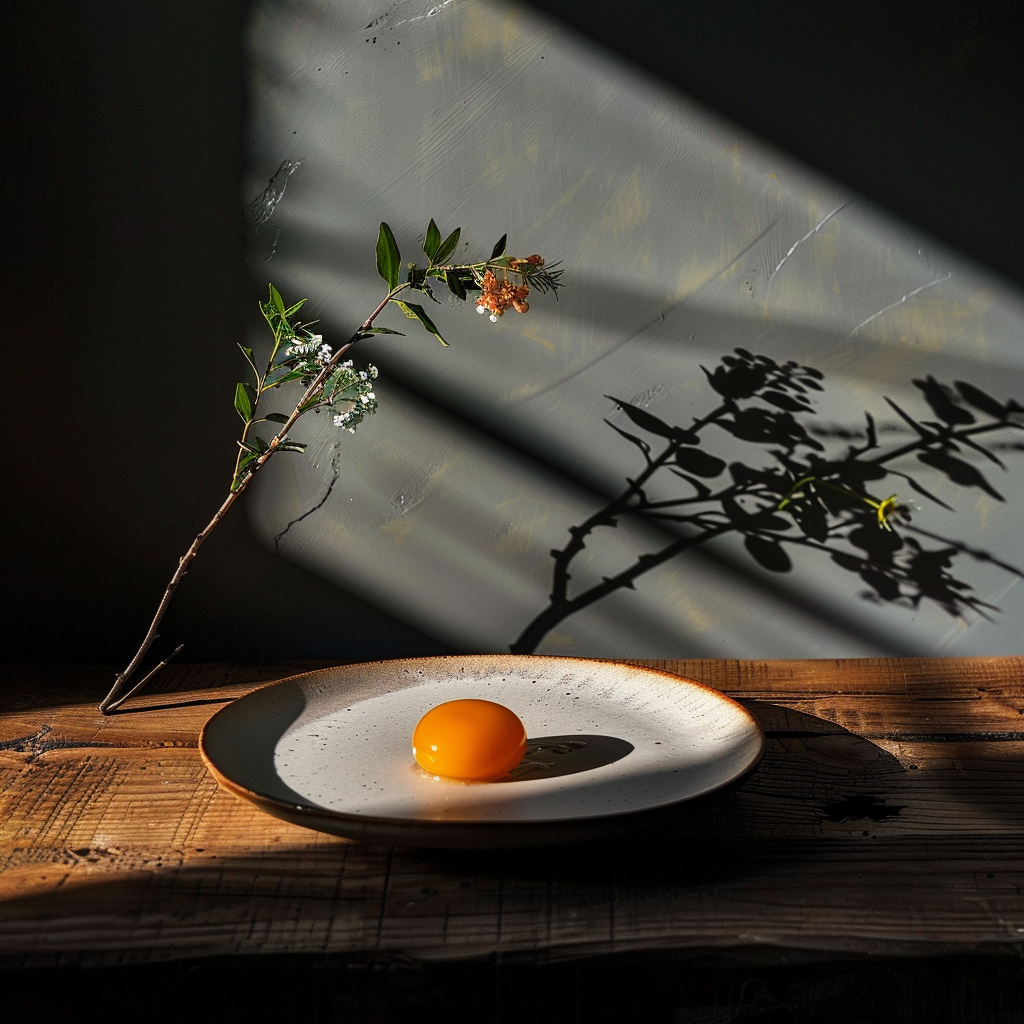
If you want your food photos to look more real, it’s important to tone down the shadows. Strong shadows can take away from the food by creating a contrast that doesn’t look right.
You can fix this by using things like a piece of white cloth or paper to scatter the light. This goes between your light and the food. Also, you can use things that reflect light, for example, white boards or even aluminum foil.
These help by shining light on the dark parts, making them lighter and less harsh. By playing with light like this, the food looks more appealing and natural.
Creating Mood with Lighting
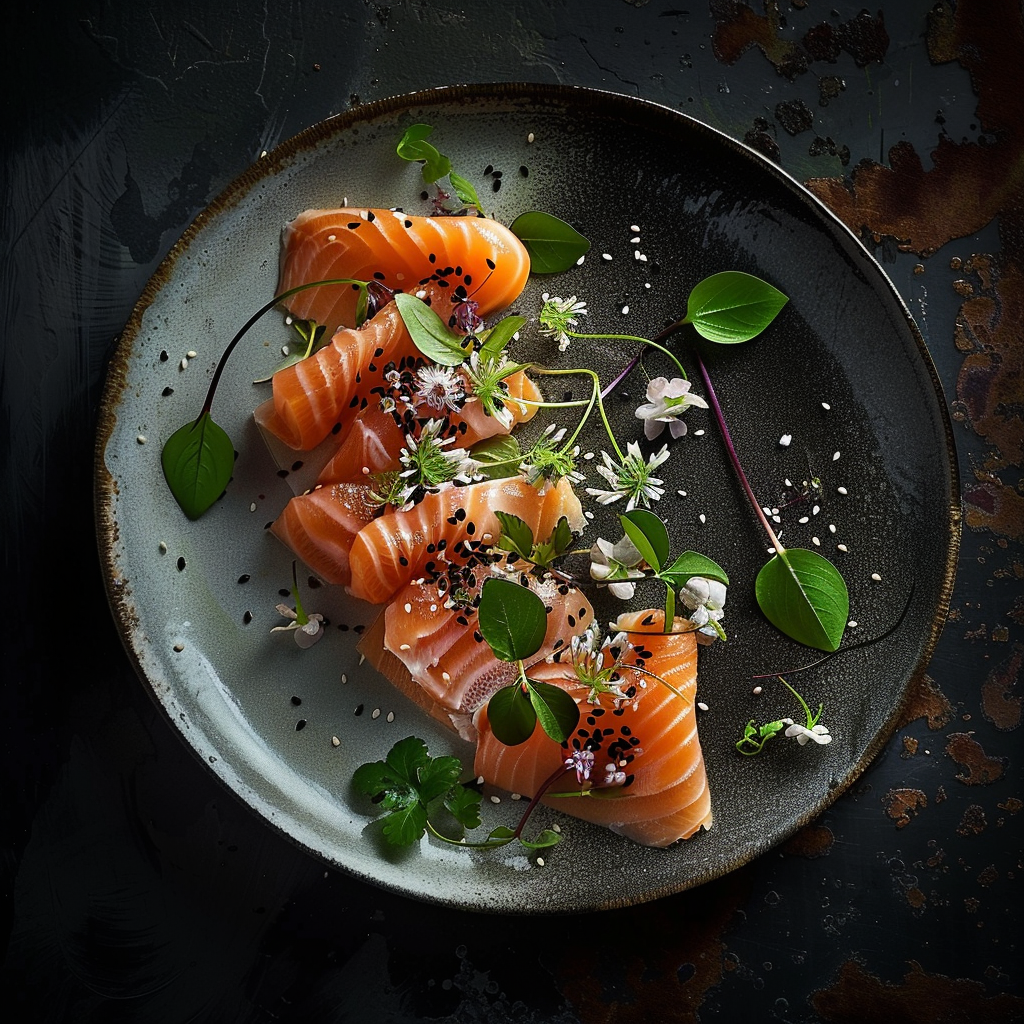
Lighting does more than just make things visible. It can evoke emotions and set the mood. For a cozy and intimate feeling, go for soft and warm Lighting. To bring out freshness and energy, use bright and cool lights instead. Play with the color of the light, its direction, and how strong it is to control the feeling you want your photos to capture.
Aperture and Depth of Field in Food Photos
The aperture setting is crucial when shooting food because it determines how much light gets through your camera’s lens and the depth of field of your photo. A big aperture (which means a smaller f-number) blurs the background and focuses on the food, while a small aperture (a bigger f-number) makes everything sharp. This can be good for showing a whole table setting clearly.
Shutter Speed and Its Effects on Food Imagery
You need to manage shutter speed well, especially if you’re capturing movement in your food pictures. A fast shutter speed will stop action in its tracks, perfect for crisp pictures of splashing or dripping. On the contrary, go slower with the shutter if you want to show something like syrup pouring smoothly or ice cream melting. But remember, slow speeds might need extra support for your camera to prevent shaking.
ISO Settings and Noise Considerations
Working with ISO settings is about finding a balance between having enough light and avoiding noise, which looks like grain in your photos. A low ISO keeps your images clean. But in darker situations, you might have to increase the ISO. Just watch out as higher ISO can mean more noise, which may hide the yummy details in your food shots.
Taking good pictures of food isn’t only about the photo shoot itself. After taking the photos, editing can make them look even tastier. Here are several key methods to improve your shots.
Basic Editing Techniques for Food Photography
After you take your pictures, it’s time to polish them with basic editing tools. Adjusting brightness, contrast, and sharpness can really make the colors and textures stand out.
Enhancing Colors and Contrast in Post-Production
Improving colors and contrast is key when editing. It can turn a dull photo into something that pops with life. By tweaking saturation and the balance between light and dark areas, you can make the food look more irresistible but keep it real at the same time.
Cropping and Framing for Better Composition
An image lives or dies by its composition. Sometimes cropping helps get rid of distractions or puts the focus where it should be. Frame your shots with the rule of thirds in mind to add interest. Your goal should be guiding viewers straight to the best part—the delicious food!
Edit wisely because you want the dish in your photo to look tempting but real.
To get better at food photography, you’ll need to master a few complex techniques that’ll add depth and originality to your photos.
Playing with Angles for Unique Perspectives
Different angles can completely change how your food photos look and feel. Shooting from above is great for dishes like soups or salads or to capture a full table spread. Eye-level shots show off layers or height like burgers or cakes.
Macro Photography for Detail in Food
Macro photography lets you highlight details that usually go unnoticed. You’ll need a macro lens for this style, and it’s great for things like capturing tiny grains of salt on pretzels or beads of water on fresh produce.
Motion and Action Shots in Food Photography
If you want to add dynamism to your food images, try including action shots like pouring sauce or tossing a salad. Use different shutter speeds and stabilize your camera with tripods or monopods when needed.
With action shots, make sure your lighting follows the motion so everything stays well lit.
Dealing with Reflective Surfaces
Shiny utensils and glossy surfaces can be distracting in food photos. Photographers manage this using diffusers to soften light or changing their angle to avoid reflections. In some cases, a polarizing filter can also help reduce glare.
Maintaining Food Freshness During Shoots
It’s important to make your food look freshly prepared in photos. Keep dishes looking good by having your camera and lights ready before bringing out the food. Some secrets include brushing food with oil for shine or misting it with water for a fresh look. You might also use substitutes like wet cotton balls for steam.
Overcoming Poor Lighting Conditions
Good lighting is vital in this kind of photography—bad lighting can spoil a great shot otherwise. Tackle dim light using tripods for longer exposures without blur or artificial light sources for consistent illumination. Reflectors can also fill shadows to make sure every detail appears clear and bright.
Exploring the Art of Food Photography
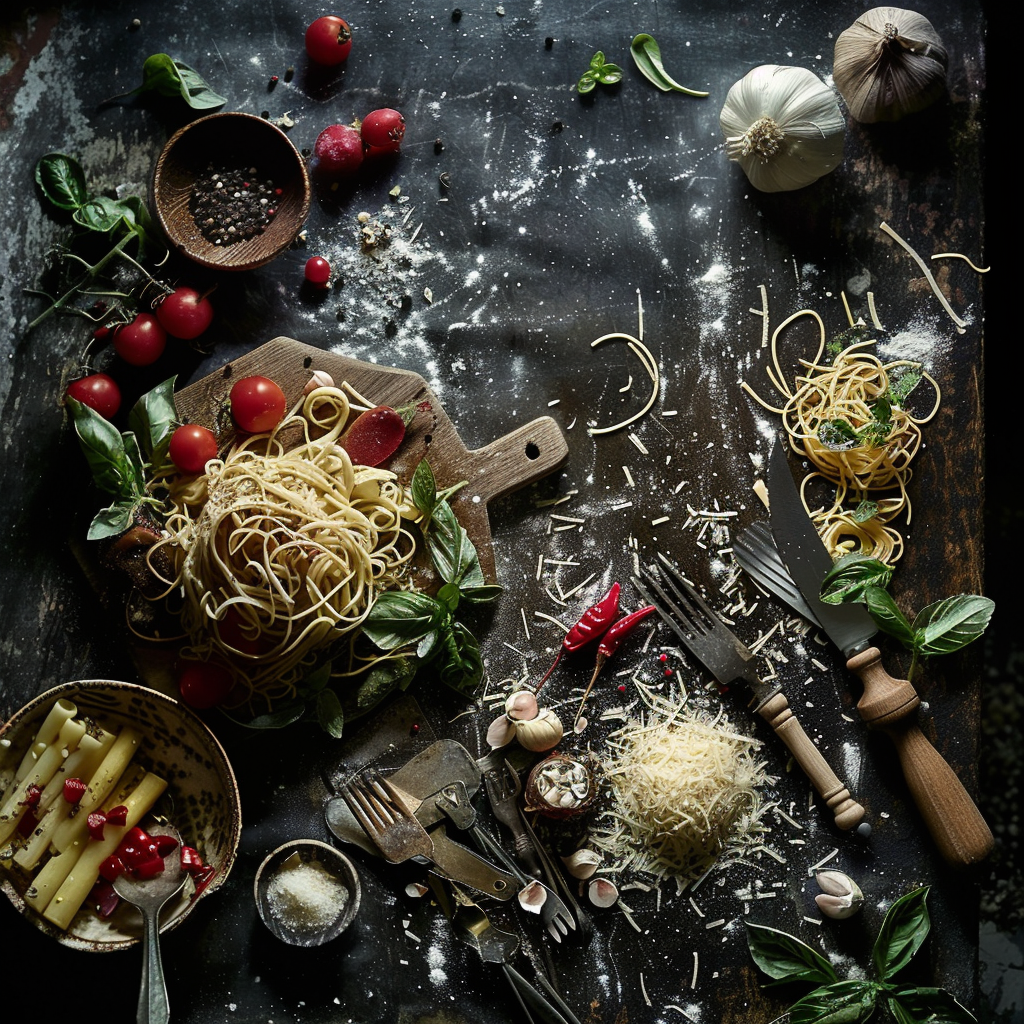
Food photography is all about taking pictures of food that look attractive. It’s where cooking meets picture-taking to do more than just make your mouth water – it’s about telling a story. Photographers use different tricks to make the food pop and get across what it’s really like.
Bringing Stories to Life Through Food Imagery
Telling a story with pictures of food can stir up emotions and tell deeper tales. Maybe it shows how a meal’s made, shares where it comes from, or gives a peek into a chef’s day. Every photo’s like a page in a book, inviting you into a world full of flavors.
Dabbling in Varied Styles and Genres
Food photos aren’t one-size-fits-all – there are heaps of styles, from classic to quirky. Some photographers go for bright and bold pictures that scream “fresh!” while others might choose cozy, dimly lit images. It’s up to the photographer whether to keep things simple or jazz up the picture with lots of extras. Each approach shows off food from a new viewpoint.
Incorporation of Human Elements in Food Photography
Adding people or just a human touch, like a hand sprinkling herbs, makes food photos come alive. It makes you feel connected because eating is something we all do together. Catching these moments adds energy and makes the whole thing more real.
Photographers have to stay original and can’t keep recycling old ideas. Mixing up subjects, how things are placed, and trying new methods helps creativity bloom. They aim to snap shots that are true to life and make you really feel them.
Selecting Your Best Work for a Portfolio
A good portfolio starts with picking your top photos. Mix it up, show off what you do best, and don’t forget that it’s not just about looking good – it’s also showing you’ve got the skills. The pics you choose should be like a showcase of all kinds of meals and techniques, wowing anyone who takes a look.
Utilizing Social Media to Showcase Food Photography
Social media is key for getting your food pics out there. Pick platforms that fit who you want to reach and post often so people remember you. Instagram and its love for photos makes it perfect for showing off your work. Smart hashtagging and tagging the right folks can help even more people find your photos. But don’t overdo it – better to nail a few platforms than spread yourself too thin.
Networking and Collaboration Opportunities
Meeting other food photographers can take you places. Go to events, chat with chefs and other snappers, and you could end up working on cool projects together. This can mean more people see your work when you share each other’s stuff. Plus, fresh ideas can grow out of working together.
Staying Updated with Food Photography Trends
Like clothes or gadgets, food photography keeps changing. So keep an eye on what’s hot by checking out magazines and what influencers are doing online. This can give you new ideas for how to set up your shots and keep your work interesting.
Practicing Consistently to Hone Skills
Keep on snapping to get better – the more photos you take, the sharper your skills will get. Every time you try shooting in a new light or arranging plates differently is a chance to learn something new, making those skills stick so they’re ready when it counts.
Attending Workshops and Courses for Improvement
If you’re serious about getting better at this, think about workshops or courses because:
- Structured Learning: They give you proper tips and shortcuts to improve faster.
- Networking Opportunities: You’ll meet other photographers who can give advice or maybe even team up with you.
- Access to Resources: Sometimes these classes let you play with fancy equipment or give you materials you wouldn’t have otherwise.
Hitting up classes designed for food shooters can fill in the blanks in what you know and helps make your pictures look even tastier. Whether it’s learning fresh editing software tricks or getting hands-on with lighting gear, every lesson is one step closer to nailing that perfect shot.
Frequently Asked Questions (FAQ)
How can images of dog food be captivating in photography?
Capturing dog food images requires employing a variety of techniques to make the often mundane subject matter visually appealing. As a photographer, it’s essential to consider the texture and color contrasts that can add interest to your images. Using natural light or soft flash can enhance the textures, and including elements such as a pet’s favorite toy or using garnishes can offer a sense of place and hint at a lunch-break scene. The juxtaposition between the food and these elements can create engaging photographs that stand out.
What styling tips are key for Chocolate and Confectionery themed sessions like Holiday Cookie Exchanges?
When it comes to styling chocolate and sweet treats for a Holiday Cookie Exchange or themes such as ‘CONSUETUDINI D’AUTUNNO: BROWNIES CASTAGNE E CIOCCOLATO,’ the detail lies in the arrangements and the ornaments used. A food photographer should look for Premium props that complement the chocolates’ rich colors. Ideas might include peppermint accents, festive Gift Wrapping materials, or even elements that evoke the scent of bake chocolate delights. It’s all about creating a scene that tells a part of the story, evoking a seasonal atmosphere with color schemes that echo Dark Christmas motifs.
In constructing an engaging lunch scene, what role does prop selection play?
Prop selection is crucial in constructing an engaging lunch scene as it sets the stage for the story you want to tell through your images. The right choice in tableware, linens, and background elements can transport viewers into the world of your food scene, whether it be a quick burger break or an elegant slice of cheesecake. For instance, imagine how a simple brown mushroom burger could be enhanced by rustic bundles of wheat or farm-style napkins; this not only adds depth but also complements the subject with natural tones. Styling your shot with festive decorations or specific colour motifs can turn a regular item into a seasonal statement like Christmas-themed brownies enriched with cocoa, or a chocolate cake adorned with Pecans and CARDAMOM – each detail contributing to the bigger picture.
Why is understanding the Rule of Thirds significant for food photographers?
Understanding and applying the Rule of Thirds is significant because it helps photographers create balanced and visually appealing compositions. By imagining your frame divided into nine equal parts with two equally spaced horizontal lines and two vertical lines, placing key elements of your food images along these lines or at their intersections can result in more engaging photographs. This technique encourages viewers’ eyes to move around the image, making every part of the photograph pronounced, from pesto swirls in a recipe dish to sprinkles on a cupcake.
How do factors like aperture, shutter speed, and ISO contribute to capturing Perfect Shots in food photography?
Aperture, shutter speed, and ISO are the trifecta of camera settings that control exposure and affect the creative outcome of food photographs. The aperture determines how much light enters the lens and impacts depth of field – a wider aperture (lower f-stop number) will blur the background while keeping the main subject sharp. Shutter speed allows photographers to freeze motion or create blur; fast speeds are essential for stopping action, like capturing sprinkles falling onto a cake. Lastly, ISO affects sensor sensitivity – higher ISOs assist in low-light conditions but can introduce noise into your images. When adjusted carefully in unison, these settings help food photographers in achieving their vision whether it’s showcasing steam rising from Hot Chocolate or highlighting the gloss on freshly glazed confections.
Can incorporating human elements boost the impact of food imagery?
Absolutely! Incorporating human elements into food photography can significantly boost its impact. Actions like a chef’s hand expertly drizzling sauce onto a dish or family members reaching in to grab a slice of cake can infuse life and movement into your images. These elements not only show scale but also convey emotions and could tell a story –such as the joy of sharing during a family gathering or the concentration of an artist decorating holiday cookies. Capturing shots with human interactions provides a connectivity factor, resonating with viewers on an intimate level.
What food styling tips work best for enhancing desserts like cheesecakes in photography?
Styling desserts, particularly cheesecakes, involves utilizing various tips to highlight their creamy texture and scrumptious toppings. When approaching cheesecake food photography, one might consider arranging complementary ingredients around the dessert – think blueberries or fresh mint – employing subtle garnishes that don’t overwhelm the main subject. Selective focus can draw attention to areas with contrasting textures like crumbly crusts juxtaposed against smooth cheese filling. Lighting plays a pivotal part too; diffuse light enhances the subtleties of high moisture foods like yogurt toppings on cheesecakes. Accessories and backdrops should harmonize with the dessert’s appearance; neutral porcelain plates can present an elegant simplicity ensuring the cheesecake remains the hero of the shot.
What strategies should be applied to improve photographing burgers to entice viewers?
Burger photography requires strategies that emphasize their tempting layers and textures while making them look fresh and succulent. Use direct but diffused lighting to cast gentle shadows that define the burger’s structure without overwhelming it. Experiment with different angles; possibly, a bird’s-eye view to showcase toppings or a side angle to emphasize stack height. Employ techniques such as brushing oil on patties for added sheen or using toothpicks to keep layers in place. Vivid colours from side dishes like cole slaw or pickles serve as visual accents, not forgetting adding details to the background such as craft paper or wooden boards which denote rustic quality and heartiness.
How important is post-production in refining food images for photographers?
Post-production is vital in refining food images, as it allows photographers to make subtle adjustments that elevate their shots from good to great. Techniques such as correcting white balance ensure colors appear natural and true to life, while fine-tuning exposure can correct any overlooked lighting issues. Cropping can also be used to improve composition post-shoot. For food photographers who cater to specific branding needs, editing helps align their creations with promotional or advertising narratives by adjusting saturation for impactful product colors or applying localized edits to bring out texture details such as seeds on buns or ice crystals on frozen desserts.
What tactics help capture dynamic action shots in food photography?
To capture dynamic action shots in food photography, tactics such as fast shutter speeds are essential for freezing motion without blur – perfect for snapping that moment where flour is being sifted onto dough or capturing splashes from a drink being poured. Pairing fast shutter speed with continuous shooting mode means never missing the peak moment of an action sequence. Anticipation plays its own role; having everything set up before embarking on actions like bursting berry packs over pancakes ensures readiness when that split-second moment occurs. Additionally, pre-focusing on where the action will happen helps keep imagery sharp where it counts.
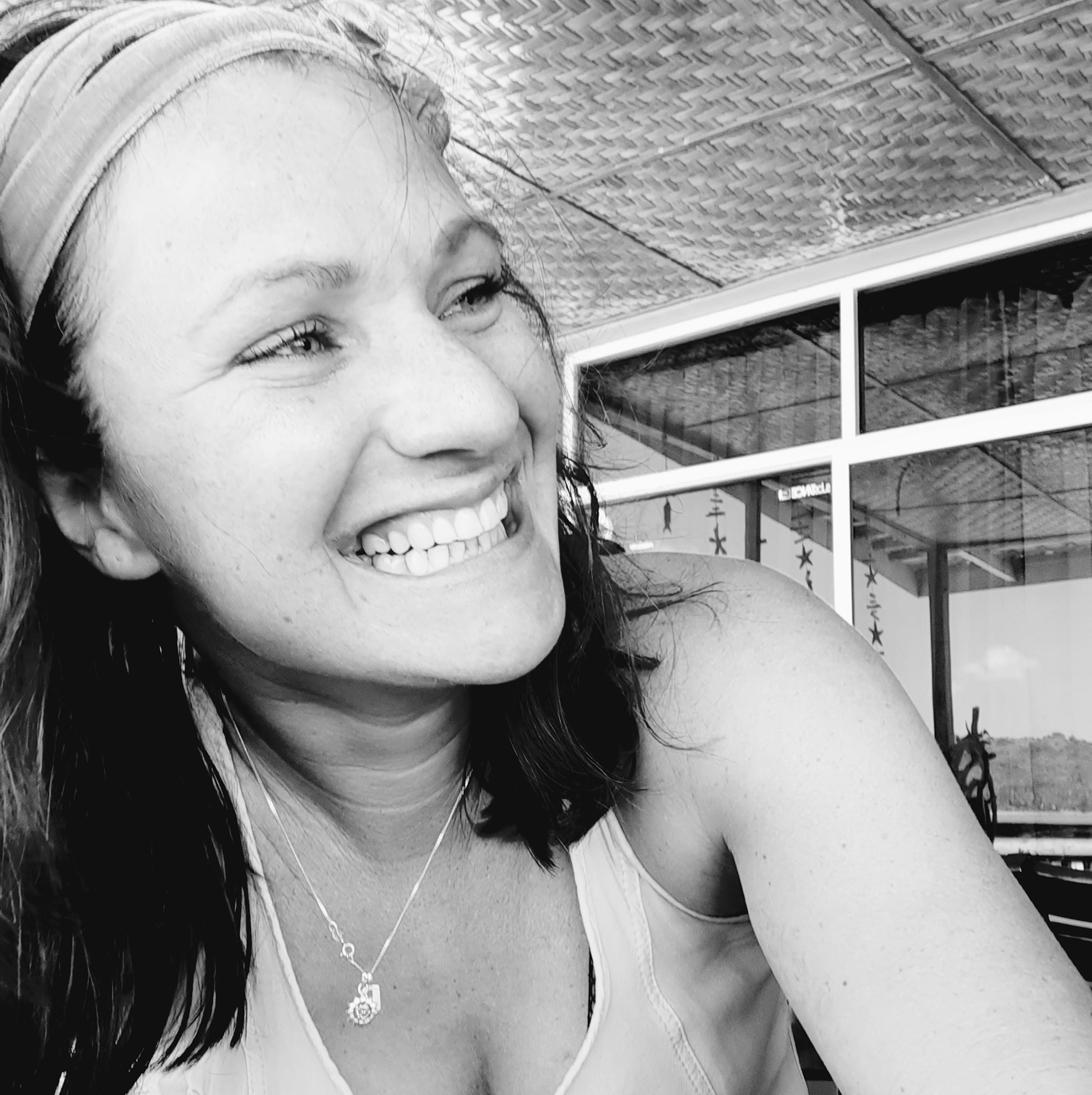
About Author
Rachel Noël is a professional photographer and videographer from the UK with over 10+ years of experience. Rachel specializes in Underwater, Tavel & Portrait photography among other areas.
